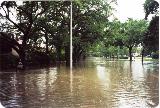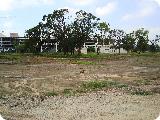Multiple Measures
Protected University from Floods
Harris County, TX – As a leading research institution with a distinctive commitment to undergraduate education, Rice University aspires to path-breaking research, unsurpassed teaching, and contributions to the betterment of our world. Unfortunately, it shares a history of flooding with other critical facilities in Houston. To protect its property against floods, the university has invested over $2 million in flood mitigation measures with astounding success. When Hurricane Ike slammed into Texas in September 2008, the university experienced rising water from the deluge of rainfall that accompanied Ike, but did not flood.
“Wwe have a great deal of surface flooding. With a strong summer thunderstorm, we would get surface flooding,” said Doug Tomlinson, assistant vice president in the Project Management and Engineering Department at Rice. “The water would impede traffic flow.”
In 2001, Tropical Storm Allison devastated southeastern Texas. The storm dropped heavy rainfall along its path, peaking at over 40 inches in Texas. The worst flooding occurred in Houston. Downtown Houston was inundated, causing severe damage to hospitals and businesses. Rice was not spared.
“Following Tropical Storm Allison, we had a lot of surface flooding,” continued Tomlinson. “We have a bunch of underground utility systems that provide services to the campus. We got some water in them, which migrated to some of the buildings. We had water come in through some basement level windows also. In some places the water got up as high as five feet. Street flooding was probably around two feet.”
While Tropical Storm Allison may have been a deciding factor in the university’s decision to apply for funding to initiate mitigation measures, poor drainage was a constant woe long before the storm.
A portion of the university’s 285 acres sits on top of what is commonly known as Harris Gulley. Back in the 1950s, two, 11-foot by 11-foot box culverts were installed. Surface water was supposed to drain off the campus into Harris Gulley before finding its way to the Brays Bayou. Over time this feat became less likely. With the amount and rate of rainfall, Harris Gulley would surcharge, and water would simply stand on the surface.
“The [mitigation] projects executed following Tropical Storm Allison were multiple small projects; however, all were initiated as a result of the storm,” said Tomlinson.
The university received a $2,059,747 grant from the Federal Emergency Management Agency (FEMA) through its Hazard Mitigation Grant Program (HMGP) to fund 11 projects. HMGP pays 75 percent on approved projects that will prevent or reduce damage from storms and other natural hazards. These grants are made available for both public and private projects. With Rice University’s 25 percent portion, the total funding was $2,746,328.
Harris County,
Texas



Quick Facts
Year:
2001
Sector:
Public
Cost:
$2,059,747.00 (Actual)
Primary Activity/Project:
Flood Control
Primary Funding:
Hazard Mitigation Grant Program (HMGP)

